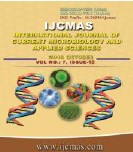


 National Academy of Agricultural Sciences (NAAS)
National Academy of Agricultural Sciences (NAAS)

|
PRINT ISSN : 2319-7692
Online ISSN : 2319-7706 Issues : 12 per year Publisher : Excellent Publishers Email : editorijcmas@gmail.com / submit@ijcmas.com Editor-in-chief: Dr.M.Prakash Index Copernicus ICV 2018: 95.39 NAAS RATING 2020: 5.38 |
Vitamin B6, also called pyridoxine, is one of the B vitamins. It helps the body to convert food (carbohydrates) into fuel (glucose), which is used to produce energy. A simple and sensitive reversed-phase (RP) HPLC method was used for determination of vitamin B6 present in areca nut samples. Areca nut samples were collected from Shimoga, Davanagere, Chikkamagalur, Chitradurga, Dakshina Kannada and Udupi districts of Karnataka, India. RP- HPLC analysis was performed with UHPLC system (Thermo fisher-ultimate 3000) equipped with UV/Visible detector and C18 column. The column effluents were monitored at 220nm. Vitamin B6 in different district ranged from 10 to 91 ppm. The mean vitamin B6 content was lowest in Shimoga district (15.68 ppm) and highest in Dakshina Kannada district (50.49 ppm). Vitamin C is a most important vitamin in the human diet, excessively present in fruits and vegetables. It is also known as ascorbic acid and is water-soluble. In areca nut vitamin C is present in trace amount. The dried powdered areca nut samples were used for the estimation of vitamin C content and it was determined by redox titration with potassium iodate in the presence of potassium iodide. The titration method is very simple and fast method. The Concentration of vitamin C varied in areca nut samples collected from different district of Karnataka. Highly significant variations existed in Vitamin C content among samples collected from 35 taluks of 6 districts. The range of Vitamin C was 264-1408 ppm among 117 samples collected from hoblies of Karnataka. The variation may be due to varietal differences; mode of cultivation, soil types and processing methods.
 |
 |
 |
 |
 |